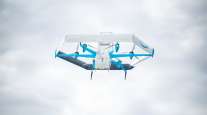FAA Proposes Opening Skies to Drones But Not For Delivering Packages

The U.S. government’s first attempt at widespread approval for the use of small unmanned aircraft could change how some everyday business activities get done, bridge inspections being one. It may produce at least $100 million in economic benefits, according to an analysis by President Obama’s administration.
What it won’t allow are the kind of autonomous flights envisioned by companies such as Amazon.com Inc., Google Inc. and Alibaba Group Holding Ltd. At least not yet. Even the initial uses are at least two years away.
“This is not the last word, by any means,” Michael Huerta, chief of the U.S. Federal Aviation Administration, told reporters on a conference call Feb. 15 from Washington.
For the time being, FAA has concluded that small drones for hire must be flown within sight of an operator and away from crowds for safety reasons.
Those restrictions not only will prevent Amazon from making deliveries by drone, they may limit other uses companies were awaiting, such as long-range pipeline inspections and news-media photography of public events, according to Patrick Egan, an editor at the informational website suasnews.com who participated in the industry committee that advised FAA on the rule proposal.
“It is pretty limiting, but we need to open the door somewhere,” Egan said in an interview.
FAA identified at least four areas in which it said small unmanned aircraft can be beneficial: photography, agriculture, law enforcement and search and rescue, and inspecting structures such as bridges and telecommunications towers.
The Washington-based Small UAV Coalition, which represents Amazon and Google, said the proposal, while welcome, was too cautious on several fronts.
Allowing drones to fly longer distances using video and other sensors for guidance “is critical to unleashing the power of automation in this space,” the group said in an e-mailed statement.
FAA also should give drone operators more leeway to fly over people who aren’t involved in the flight operation, it said.
The regulator, other government agencies and industry groups are studying new technology that may someday allow the Amazons of the world more freedom to fly, Huerta said.
Those technologies include how to install devices that will sense other drones or obstructions so unmanned craft can avoid collisions, he said.
The agency also has a process to grant waivers allowing broader uses if companies can show it is safe, he said.
Amazon didn’t immediately respond to e-mailed requests for comment.
Even companies willing to live by the restrictions won’t be able to operate immediately. FAA must review what probably will be an onslaught of public comments seeking changes to the proposal, a process that may take years. An FAA policy statement on hobby-drone flights last year drew more than 30,000 comments.
The regulations may not be completed until 2017 at the soonest, Gerald Dillingham, the Government Accountability Office’s director of physical infrastructure issues, told Congress at a Dec. 10 hearing.
“This is a good first step in an evolutionary process,” said Brian Wynne, president and of the Arlington, Virginia-based Association for Unmanned Vehicle Systems International. The rule was “long overdue.”
Congress mandated in 2012 that FAA, which primarily regulates piloted airplanes, find a way to safely integrate unmanned aircraft in U.S. skies by Sept. 30, 2015, a deadline that the government already had said won’t be met.
Helen Greiner, CEO of CyPhy Works Inc., said it’s still “a great day for drones.” Her Danvers, Massachusetts-based company develops unmanned aerial vehicles for use in the real estate, agricultural, security and energy industries.
Greiner said she was relieved that commercial drone operators won’t have to obtain a traditional pilot’s license. FAA has proposed that operators must be at least 17 years old and pass a knowledge test.
“This provides a glimmer of hope for potential commercial operators” of drone technology, Charles Easterling, founder of Crescent Unmanned System, said in a telephone interview. “There are a lot of startups out there that have been waiting for this and for potential users, it sets their minds at ease.”
Chris Polychron, president of the National Association of Realtors, said the FAA proposal is “good news for property owners and Realtors who desire to embrace cutting-edge technology to enhance the process of buying and selling real estate with images gathered by unmanned aerial vehicles.”
At the same time, the group discouraged its members from using drones to photograph properties because the practice, while openly advertised by some companies, isn’t yet allowed without an FAA exemption. The agency has granted permission to only one real-estate photography business.
Representative Rick Larsen, a Washington Democrat who is his party’s highest ranking member on the House aviation subcommittee, defended FAA’s approach.
“Given the magnitude of the safety implications, we must give the FAA credit for proceeding with caution,” Larsen said in an e-mailed release.




